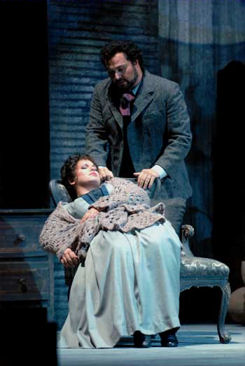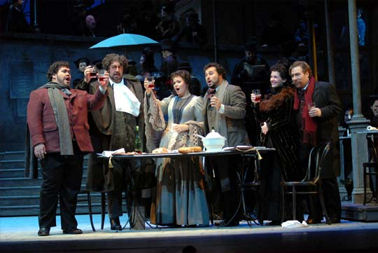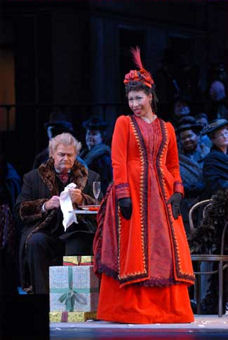Other Links
<Editorial Board
- Editor - Bill Kenny
- London Editor-Melanie Eskenazi
- Founder - Len Mullenger
Google Site Search
SEEN
AND HEARD INTERNATIONAL OPERA REVIEW Puccini,
La bohème: Soloists, Chorus and Orchestra of Lyric
Opera of Chicago, Chicago Children's Choir, Sir Andrew Davis
(conductor) Lyric Opera Center, Chicago 13.10.2007 (JLZ) Set and Costume Design - Pier Luigi
Pizzi Lighting - Christine Binder Musetta – Nicole Cabell Rodolfo – Roberto Aronica Marcello – Quinn Kelsey Colline - Andrea Silvestrelli Schaunard – Levi Hernandez Benoit/Alcindoro
– Dale Travis
The stage set must dominate the second act, and the tableau
offered by Lyric’s production is a multidimensional recreation of
a Parisian street. The choruses and supernumeraries are part of
the elaborate choreography which suggests the Christmas
festivities and simultaneously allows the principals to comment on
the scene. This was a bustling, lively exploitation of Lyric's
stage and chorus that almost deserved applause for
stage-management alone. Yet when Musetta enters the scene, her
character at once offers a solution to the financial dilemma of
the first-act Bohemians and also complicates their lives. This
role requires more than comic timin: it must show the romantic
leanings that convince Musetta to forego her rich companion
Alcindoro (played by Dale Travis) and return to the love that she
once shared with Marcello. With her clear, almost effortless
soprano voice, Nicole Cabell gave a fine reading of the famous
waltz-aria that dominates the act. While addressing all the comic
demands of the role, Ms Cabell gave a fine interpretation of the
number without any of the affectations that some singers
bring to it.
Marcello, the painter, must become a catalyst for the lovers in
the third act, and Quinn Kelsey did this nicely as his character
questioned Mimí and Rodolfo about the problems they
were having. By rights, Marcello must come to the fore in
this critical part of the drama, and Kelsey did so convincingly.
Not only did he serve as a vocal foil, but his stage presence
worked commandingly as he stood between Rodolfo and Mimi
before they confronted one another near the end of the act. In
the duet with which the scene ends, Mimí and Rodolfo are
together, and while they state that it will be only until Spring, the
staging suggests all of the infatuation with which the first act
concluded. Pictures
©
Dan Rest/ Lyric Opera of Chicago
Production:
Stage Director – Renata Scotto
Chorus Master - Donald Nally
Cast:
Mimí - Elaine Alvarez 
Rodolfo – Roberto Aronica and
Mimí - Elaine Alvarez
Among the delights of the 2007-2008 season of Lyric Opera of
Chicago is its exceptional production of Puccini’s La bohème
(1897). With attention to all the details of this familiar opera,
this finely cast and well-executed production conveys a sense of
excitement to the work. It is, after all, solid theater with
excellent music, yet La bohème also requires a highly
talented and experienced cast to elicit the strong response that
the audience gave on Saturday and throughout this run of
performances. As much as La Bohème is a staple of modern
opera repertoire, a finely nuanced production like the present one
offered by Lyric Opera of Chicago, will remain in memory for
years.
From the very first scene, tenor Roberto Aronica set the tone for
the performance with his strong and accessible characterization of
Rodolfo. Aronica demonstrated both power and expression in the
exchanges between his colleagues Marcello and Schaunard in their
familiar struggle to make their marks in the world. Painter, poet,
musician, and philosopher, they represent the various kinds of
Bohemians who habituated nineteenth-century Paris. Yet their
personal lives are also a foil for comic, romantic, and
tragic elements with which everyone can identify. The delivery of
lines that juxtapose remarks about painting with the temperature
of the room must sound facile to be effective, and the performers
succeeded well in this regard, forming what seems an almost ideal
cast.
As Rodolfo, Aronica became increasingly prominent as the first act
progressed, and his delivery conveyed the warmth that one hopes to
find in the character. Yet in the latter part of the act, after
Mimí enters, Aronica seemed even more nuanced, as he became
infatuated with her. His voice took on the sensitivity that
underscored the role and the voice was colored
effectively, as he worked with Elaine Alvarez. Near the end of the
act, with the duet “O soave fanciulla,” their voices merged well
into a single sonority that epitomized the text.
As Mimí Elaine Alvarez was similarly engaging through her
singing and persuasive acting. Her vocal tone and body language
conveyed the character beautifully, with a fine stage presence
that allowed her to work well with Aronica. With Ms Alvarez, the
familiar “Mi chiamano Mimi” becomes a kind of confession, a formal
aside, in which she defines her character. Without introducing
anything unorthodox, it is her phrasing that made the difference,
as her clearly articulated vocalizing brought out the subtleties
of the libretto. If the decision to have her substitute for Angela
Gheorgiu occurred late enough to necessitate the inclusion of an
insert in the program, it did not reflect on any kind of
last-minute casting. Ms Alvarez has sung the role elsewhere, and
in this production, she offered the fine kind of
interpretation that easily meets - or exceeds - the Chicago
Lyris Opera's usual standards.
Act II Principals

Musetta – Nicole Cabell
Renata Scotto' s sure hand seems evident with details like this. While
the set and costume design for this production of La bohème
was part of the 2001-2002 season, Scotto directed this revival,
and her sensitivity to this opera is always clear. As the
final act recapitulates earlier elements, the sense of Mimi’s
impending death and Rodolfo’s tragedy emerge
subtly. In casting such a fine performer as Andrea Silvestrelli in
the role of Colline, the overcoat aria, “Addio, vecchia zimarra”
becomes the effective metaphor that Puccini intended as
the work proceeds to its dénouement.
Once
again, it is in attending to details like
this that makes this
production of La Bohème memorable. And iith a conductor as
astute as Sir Andrew Davis in the pit, the result is satisfying on all
counts, with the orchestra responding instantly to his attentive
leadership. The balance problems that emerged earlier in the
season with La traviata were completely absent in this production, and
the enthusiastic fortes in the second act were lush and
never overwhelming. No single element stood out in this
well-considered production: rather, the uniform level of quality and
attention to details that audiences have come to expect of Lyric
Opera made this production of Puccini’s familiar work a
rewarding evening of music and theater. Exactly as opera should
be, in fact.
James L Zychowicz
